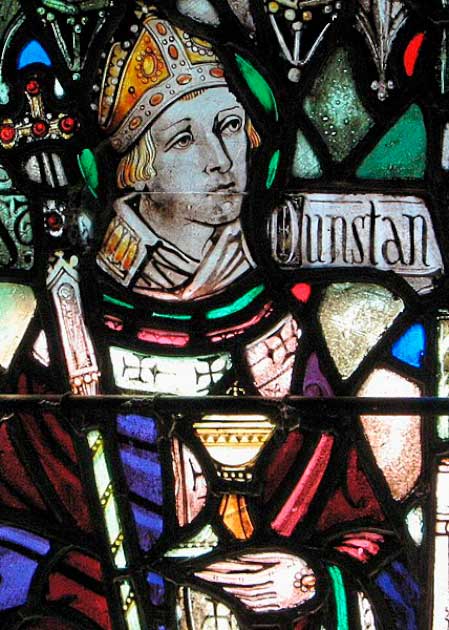Aelfthryth, or Ælfthryth was a Saxon Queen: mother, stepmother, and wife to a succession of kings. Born in 945 AD, she found herself in the decidedly Anglo Saxon world of England, a hundred years before the Norman Conquest changed the country forever.
She married twice in her life. Her first husband was an Ealdorman (a King’s deputy) of East Anglia, and her second husband was Edgar, King of the English. She would end her life in the Abbey of Ely as a nun, rising to the position of abbess.
Later, the Catholic Church recognized her as a saint, and her cult became very popular in England in the Middle Ages. However there are certain aspects of her life which will go down in infamy, for it would seem that this scheming queen was not above murder to ensure the succession of the English throne went according to her plan.
There were many problems to be overcome. King Edgar certainly seduced her, and they lived together as a couple but it is unclear whether both are married to each other. But when she gave Edgar a baby boy, named Aethelred, she was determined to have him recognized as legitimate.
After King Edgar’s death in 975, he left his elder son Edward from an earlier marriage as his heir. However Edward would not rule for long, and many sources claim that Aelfthryth was the murderer of his stepson Edward.
Was Aelfthryth guilty, the evil stepmother who preferred her own son to her stepson? Let’s begin with a brief introduction to Edward, tragically known as “the Martyr”.
Who was Edward The Martyr?
Edward the Martyr, also raised as a saint after his death, ruled England as an Anglo-Saxon king for three years after his father’s death, from 975 to 978. He was the eldest son of King Edgar and his previous wife Ethelfleda.
It would seem that there were questions of legitimacy surrounding Edward as well, which may have enboldened Aelfthryth to seek ambitious goals for her own son. What is certain is that Edward was only a child when he ascended the throne: 13 years old, with his half-brother Aethelred only 7.
His murder, when he was 16 years old, was shocking. While mounting his horse, he was attacked from behind by unknown assailants and stabbed to death. Falling from the saddle but still alive, he was then dragged behind the horse because his foot was stuck in the stirrup.

His death did lead to Aethelred ascending to the throne, known as “Aethelred the Unready” for his young age and the fact he was not considered likely to become king. But was it his mother who put him there?
The Assassination
The exact event of Edward the Martyr’s assassination was not well-documented, and there is much debate around the events. However, there is some consensus that the death of Edward the Martyr resulted from a power struggle and political intrigue within the royal court.
The Anglo-Saxon Chronicle , a history of the Anglo Saxons written from the 9th century to as late as 1154 (and this a contemporary source) claims that his death was unnatural and that he was killed in while visiting his younger brother, Aethelred at Corfe Castle.
The account states that Aethelred’s supporters killed Edward’s, and then set on the king himself. Overall, it needs to be noted that the death of Edward is not completely reliable. The exact circumstances of his death and the motives of his murderer have remained the subject of debate for researchers and historians.
What is certain is that his stepmother was a powerful political figure in England, the first wife of an English king to be anointed and crowned Queen of England. She. She had the means and opportunity to ill Edward, catching him unawares, and all the motive she needed in advancing her own son’s position.
But if she did it, she was truly playing a dangerous game. Edward the Martyr had strong supporters in England, and he took the throne as a relatively popular king who was widely seen as legitimate. And there are other problems with the narrative as well.
- King Vortigern and the Search for Arthur’s Britain
- Princes in the Tower: A Mystery of Missing Royalty
Edward’s own cult following, established after his death as he was made into a saint, is the source of many of the accusations against Aelfthryth. As his followers established a narrative idealizing their dead king, they needed a villain.
An Evil Stepmother?
In truth the story is only one of several possibilities for what happened to Edward. While it may be plausible, England was a dangerous place and there were many competing factions, both domestic and foreign, locked in a power struggle in England at the time.
Maybe Aelfthryth was guilty. But there were many nobles with something to gain who could have sent hired assassins to ambush Edward. He did have opposition amongst some nobles who were unhappy with his rule and looking for a ruler more sympathetic to their interest.

The third theory states that Archbishop Dunstan, who had initially supported Edward, murdered him because his supporters saw that he was a threat to achieving their own ambitions. It seems that, in the three years he spent on the throne, Edward did not impress his subjects.
After Edward’s death, the crown was given to his younger brother. However, his reign was not be a happy one either, punctuated by repeated Danish invasions and political instability.
The Danish incursions resulted in the loss of much wealth and land in England, as they established a permanent presence with their settles. Aethelred was still a child and could not lead an army, leaving his court to descent into infighting in the face of the Danish threat.
But he endured. Although his reign was characterized by military weakness, political instability, and frequent internal conflict, Aethelred ruled alone for over three decades. When he died the country was divided between the Danish conquerors and the English defenders. If Aelfthryth had schemed to put him on the throne, she may have doomed the kingdom too.
Did Aelfthryth order her stepson’s murder. She certainly had cause, but given the state of the kingdom at the time there were other dangers facing Edward. We simply cannot know for sure.
Top Image: Aelfthryth greets Edward the Martyr at Corfe Castle, shortly before his murder. Source: James William Edmund Doyle / Public Domain.
By Bipin Dimri